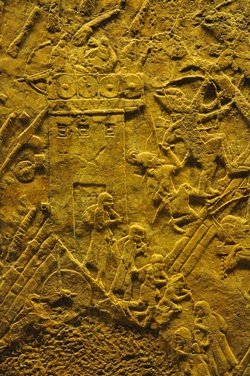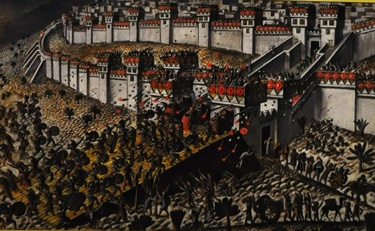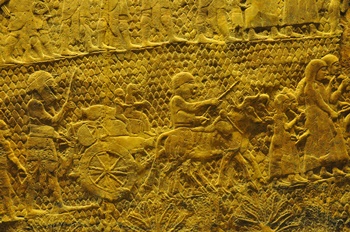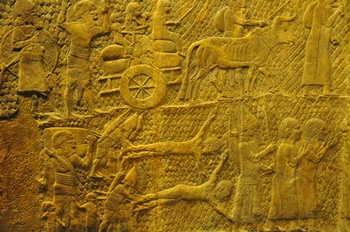Print Article
Author's Bias | Interpretation: conservative | Inclination: promise | Seminary: none

Note the tower defense, the Assyrian
siege ramps, and people escaping
from Lachish
While excavating a room in Sennacherib’s Palace in Nineveh (1845-47), Austen Henry Layard discovered a large
wall of stone carvings measuring 39 feet (12 m) high and 16.7 feet (5.10 m) long. Carved around 704-681 B.C.,
the Lachish Wall Relief depicts the Assyrian army attacking a town, soldiers breaching its walls, and prisoners
being taken away.
When Sennacherib, the king of Assyria, began his western military campaign, he took the
Phoenician coast and defeated the Egyptians before taking on the Southern Kingdom of Judah and king Hezekiah.
Lachish and Jerusalem were Judah’s most fortified cities. Lachish would fall after its siege as the Bible
records:
Now in the fourteenth year of King Hezekiah, Sennacherib king of Assyria came up against
all the fortified cities of Judah and seized them. (2 Ki 18:13)
After these acts of faithfulness Sennacherib king of Assyria came and invaded Judah and
besieged the fortified cities and thought to break into them for himself.
(2 Chron 32:1)
After this Sennacherib king of Assyria sent his servants to Jerusalem while he was
besieging Lachish with all his forces with him, against Hezekiah king of Judah and against all Judah who were
at Jerusalem, saying, “Thus says Sennacherib king of Assyria, ‘On what are you trusting that you are remaining
in Jerusalem under siege?’" (2 Chron 32:9-10)
Now in the fourteenth year of King Hezekiah, Sennacherib king of Assyria came up
against all the fortified cities of Judah and seized them.
(Isa 36:1)
Given its prominence in the central room of his palace and the only portrayal of his military victory,
Sennacherib’s Lachish Wall Reliefs indicate the importance he placed on his victory over Judah. This emphasis
is seen in Sennacherib’s Annals, Akkadian cuneiform inscriptions found on three clay Assyrian prisms (Taylor
Prism, Oriental Institute Prism, and Jerusalem Prism), which speak of king Hezekiah:

A hypothetical illustration of the Assyrian assault of Lachish
showing a siege ramp against a defensive wall / tower
© British Museum
"As for the king of Judah, Hezekiah, who had not submitted to my authority, I besieged
and captured forty-six of his fortified cities, along with many smaller towns, taken in battle with my battering
rams. ... I took as plunder 200,150 people, both small and great, male and female, along with a great number
of animals including horses, mules, donkeys, camels, oxen, and sheep. As for Hezekiah, I shut him up like a
caged bird in his royal city of Jerusalem. I then constructed a series of fortresses around him, and I did not
allow anyone to come out of the city gates. His towns which I captured I gave to the kings of Ashod, Ekron,
and Gaza."
When Layard wrote about his findings, he understood the biblical significance of the Lachish Wall Relief:
“Here, therefore, was the actual picture of the taking of Lachish, the city as we know from
the Bible, besieged by Sennacherib, when he sent his generals to demand tribute of Hezekiah, and which he had
captured before their return; evidence of the most remarkable character to confirm the interpretation of the
inscriptions, and to identify the king who caused them to be engraved with the Sennacherib of Scripture. This
highly interesting series of bas-reliefs contained, moreover, an undoubted representation of a king, a city,
and a people, with whose names we are acquainted, and of an event described in Holy Writ."

Prisoners from Lachish are being
led away by Assyrian guards

The horizontal figures are 2 Lachish
leaders being flayed alive
References:
1. Youngblood RF, ed., Nelson’s New Illustrated Bible Dictionary, Nashville: Thomas Nelson Publishers, (2014).
Copyright ©
2018
Helpmewithbiblestudy.org. All rights to this material are reserved. We encourage you to print the material for personal and
non-profit use or link to this site. If you find this article to be a blessing, please share the link so that it may rise in
search engine rankings.